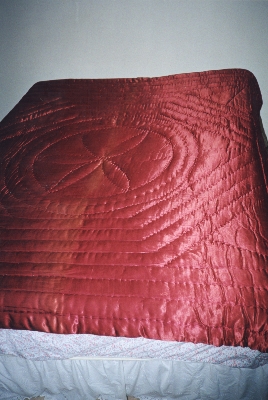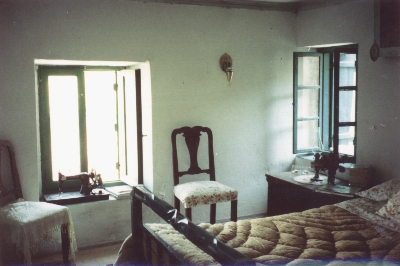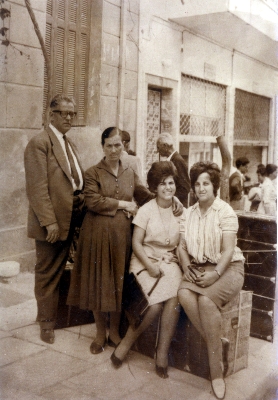Quilt No.733LK - Lily Katakouzinos

1900 x 1850mm
The quilt was made by a local quiltmaker in the Greek island of Lemnos in 1961. Lefkothea Kalogeras arranged for the quilt to be made for her daughter Maria who was migrating to Australia. It is now owned by Maria's daughter Lily Katakouzinos. It is not used.
"A Paploma from Limnos
Lily is a second-generation Greek Australian and her paploma (quilt) was made on the Greek island of Lemnos, well-known to many Australians for its beautiful natural harbour, Mudros Bay, used to launch the Gallipoli Campaign in 1915. Later, it was also the place where the armistice was signed between Britain and Turkey.
On Lemnos, in 1961, Lily's grandmother Lefkothea Kalogeras arranged for the local quilt-maker (in Greek, a 'paplomatas') to make this quilt for her daughter Maria who was migrating to Australia. The 'paplomatas' had a shop in the island's main town of Myrina, approximately thirty five kilometres from the village of Kaminia where the family lived. Lefkothea took with her the locally grown and woven cotton fabric which forms the quilt backing, then chose the lovely red satin for the main side; the padding is also of locally-grown cotton. She decided on the floral emblem for the centre, to be surrounded by parallel lines. As was the custom in those days, all the stitching was done by hand.
Maria Kalogeras, with this and several other quilts as part of her 'prika' (dowry), arrived in Sydney by plane in 1962. The following year she married Evangelo Katakouzinos, also from Lemnos; they went on to have four children: George, Lily, Ourania and Christo. Maria and Evangelo have worked hard to establish themselves in their new country, and although 'officially' retired, Maria works part-time in an aged-care facility. She recalls her early years in Greece and the traditional pre-wedding women's gatherings (a loose equivalent to our 'kitchen tea') where the bride's 'prika' (dowry) - quilts, blankets, sheets, towels etc together with a range of beautiful handworked pieces, would all be displayed in an 'doulapa anihti' (open wardrobe), which would be decorated with white tulle and satin ribbon. The traditional 'koufeta' (sugar-coated almonds) and rice would be scattered throughout, plus on the specially decorated wedding bed. Special sweets are served and traditional wedding songs are sung for the couple's future happiness. These celebrations are still held in many parts of Greece.
Lily, whose real name is Lefkothea named after this grandmother, has a background in art education and is a practising artist. One of her deep and abiding interests is traditional Greek handcrafts, so her paploma from Lemnos, together with her mother's stories, hold a special significance for her."
[Written by Lula Saunders from interview 29/4/00 for the National Quilt Register]



Related Quilts:
It is padded with hand carded wool.
1950 x 1935mm
1550 x 1321mm
2235 x 1854mm
1920 x 1756mm






